| کد مقاله | کد نشریه | سال انتشار | مقاله انگلیسی | نسخه تمام متن |
|---|---|---|---|---|
| 6427154 | 1634703 | 2016 | 9 صفحه PDF | دانلود رایگان |
عنوان انگلیسی مقاله ISI
Rapid ascent and emplacement of basaltic lava during the 2005-06 eruption of the East Pacific Rise at ca. 9°51â²N as inferred from CO2 contents
دانلود مقاله + سفارش ترجمه
دانلود مقاله ISI انگلیسی
رایگان برای ایرانیان
کلمات کلیدی
موضوعات مرتبط
مهندسی و علوم پایه
علوم زمین و سیارات
علوم زمین و سیاره ای (عمومی)
پیش نمایش صفحه اول مقاله

چکیده انگلیسی
Eruption rates at the mid-ocean ridges (MORs) are believed to strongly control the morphology and length of lava flows emplaced along the ridge axis, and thus the structure and porosity of the upper oceanic crust. Eruption rate also represents one of the few tools to gain insight into the driving pressures within sub-ridge magmatic systems. As eruption rate is inferred to vary systematically along the global mid-ocean ridge system, understanding of how to assess eruption rate in submarine systems and how it maps to observable features of the ridge axis would provide a powerful tool to understand Earth's largest magmatic system. Eruption rates at MORs are poorly constrained, however, because of a lack of direct observations, preventing the duration of an eruption to be quantified. This study uses decompression experiments of MORB samples and numerical modeling of CO2 degassing to reconstruct the timescales for magma ascent and lava emplacement during the 2005-06 eruption of the East Pacific Rise at ca. 9°51â²N. Samples collected from the lava flow are all supersaturated in dissolved CO2 contents, but CO2 decreases with distance from the vent, presumably as a consequence of progressive CO2 diffusion into growing bubbles. Samples collected at the vent contain â¼105 vesicles per cm3. Pieces of these samples were experimentally heated to 1225â°C at high pressure and then decompressed at controlled rates. Results, plus those from numerical modeling of diffusive bubble growth, indicate that magma rose from the axial magma chamber to the seafloor in â¤1 h and at a rate of â¥2-3 kmâhâ1. Our modeling, as validated by experimental decompression of MORB samples with â¼106 vesicles cmâ3, also suggests that CO2 degassed from the melt within â¼10-100 min as the vesicular lava traveled â¼1.7 km along the seafloor, implying a volumetric flow rate on order of 103-4 m3âsâ1. Given an ascent rate of â¥0.2 mâsâ1, the width of a rectangular dike feeding the lava would have been â¼1-2 m wide. MORB samples from the Pacific ridge are generally more supersaturated in dissolved CO2 than those from slower spreading Atlantic and Indian ridges. Our results suggest that Pacific MORBs ascend to the seafloor faster than Atlantic or Indian MORBs.
ناشر
Database: Elsevier - ScienceDirect (ساینس دایرکت)
Journal: Earth and Planetary Science Letters - Volume 453, 1 November 2016, Pages 152-160
Journal: Earth and Planetary Science Letters - Volume 453, 1 November 2016, Pages 152-160
نویسندگان
J.E. Gardner, B.A. Jackson, H. Gonnermann, S.A. Soule,